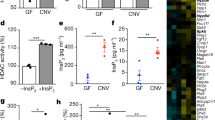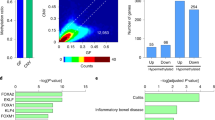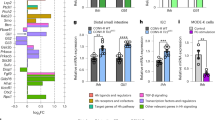Abstract
The development and severity of inflammatory bowel diseases and other chronic inflammatory conditions can be influenced by host genetic and environmental factors, including signals derived from commensal bacteria1,2,3,4,5,6. However, the mechanisms that integrate these diverse cues remain undefined. Here we demonstrate that mice with an intestinal epithelial cell (IEC)-specific deletion of the epigenome-modifying enzyme histone deacetylase 3 (HDAC3ΔIEC mice) exhibited extensive dysregulation of IEC-intrinsic gene expression, including decreased basal expression of genes associated with antimicrobial defence. Critically, conventionally housed HDAC3ΔIEC mice demonstrated loss of Paneth cells, impaired IEC function and alterations in the composition of intestinal commensal bacteria. In addition, HDAC3ΔIEC mice showed significantly increased susceptibility to intestinal damage and inflammation, indicating that epithelial expression of HDAC3 has a central role in maintaining intestinal homeostasis. Re-derivation of HDAC3ΔIEC mice into germ-free conditions revealed that dysregulated IEC gene expression, Paneth cell homeostasis and intestinal barrier function were largely restored in the absence of commensal bacteria. Although the specific mechanisms through which IEC-intrinsic HDAC3 expression regulates these complex phenotypes remain to be determined, these data indicate that HDAC3 is a critical factor that integrates commensal-bacteria-derived signals to calibrate epithelial cell responses required to establish normal host–commensal relationships and maintain intestinal homeostasis.
This is a preview of subscription content, access via your institution
Access options
Subscribe to this journal
Receive 51 print issues and online access
$199.00 per year
only $3.90 per issue
Buy this article
- Purchase on Springer Link
- Instant access to full article PDF
Prices may be subject to local taxes which are calculated during checkout




Similar content being viewed by others
References
Strober, W., Fuss, I. & Mannon, P. The fundamental basis of inflammatory bowel disease. J. Clin. Invest. 117, 514–521 (2007)
Kau, A. L., Ahern, P. P., Griffin, N. W., Goodman, A. L. & Gordon, J. I. Human nutrition, the gut microbiome and the immune system. Nature 474, 327–336 (2011)
Kaser, A., Zeissig, S. & Blumberg, R. S. Inflammatory bowel disease. Annu. Rev. Immunol. 28, 573–621 (2010)
Renz, H. et al. Gene-environment interactions in chronic inflammatory disease. Nature Immunol. 12, 273–277 (2011)
Slomko, H., Heo, H. J. & Einstein, F. H. Minireview: Epigenetics of obesity and diabetes in humans. Endocrinology 153, 1025–1030 (2012)
Mukherjee, A. B. & Zhang, Z. Allergic asthma: influence of genetic and environmental factors. J. Biol. Chem. 286, 32883–32889 (2011)
Denson, L. A. et al. Challenges in IBD research: update on progress and prioritization of the CCFA’s research agenda. Inflamm. Bowel Dis. 19, 677–682 (2013)
Ivanov, I. I. & Honda, K. Intestinal commensal microbes as immune modulators. Cell Host Microbe 12, 496–508 (2012)
Cadwell, K. et al. Virus-plus-susceptibility gene interaction determines Crohn’s disease gene Atg16L1 phenotypes in intestine. Cell 141, 1135–1145 (2010)
Gallo, R. L. & Hooper, L. V. Epithelial antimicrobial defence of the skin and intestine. Nature Rev. Immunol. 12, 503–516 (2012)
Artis, D. Epithelial-cell recognition of commensal bacteria and maintenance of immune homeostasis in the gut. Nature Rev. Immunol. 8, 411–420 (2008)
Donohoe, D. R. & Bultman, S. J. Metaboloepigenetics: interrelationships between energy metabolism and epigenetic control of gene expression. J. Cell. Physiol. 227, 3169–3177 (2012)
Perissi, V. & Rosenfeld, M. G. Controlling nuclear receptors: the circular logic of cofactor cycles. Nature Rev. Mol. Cell Biol. 6, 542–554 (2005)
Haberland, M., Montgomery, R. L. & Olson, E. N. The many roles of histone deacetylases in development and physiology: implications for disease and therapy. Nature Rev. Genet. 10, 32–42 (2009)
Kim, G. W., Gocevski, G., Wu, C. J. & Yang, X. J. Dietary, metabolic, and potentially environmental modulation of the lysine acetylation machinery. Int. J. Cell Biol. 2010, 632739 (2010)
Dashwood, R. H. & Ho, E. Dietary histone deacetylase inhibitors: from cells to mice to man. Semin. Cancer Biol. 17, 363–369 (2007)
Chen, X. et al. Requirement for the histone deacetylase Hdac3 for the inflammatory gene expression program in macrophages. Proc. Natl Acad. Sci. USA 109, E2865–E2874 (2012)
Choudhary, C. et al. Lysine acetylation targets protein complexes and co-regulates major cellular functions. Science 325, 834–840 (2009)
You, S. H. et al. Nuclear receptor co-repressors are required for the histone-deacetylase activity of HDAC3 in vivo. Nature Struct. Mol. Biol. 20, 182–187 (2013)
Alenghat, T. et al. Nuclear receptor corepressor and histone deacetylase 3 govern circadian metabolic physiology. Nature 456, 997–1000 (2008)
Fischle, W. et al. Enzymatic activity associated with class II HDACs is dependent on a multiprotein complex containing HDAC3 and SMRT/N-CoR. Mol. Cell 9, 45–57 (2002)
Montgomery, R. L. et al. Maintenance of cardiac energy metabolism by histone deacetylase 3 in mice. J. Clin. Invest. 118, 3588–3597 (2008)
Feng, D. et al. A circadian rhythm orchestrated by histone deacetylase 3 controls hepatic lipid metabolism. Science 331, 1315–1319 (2011)
Mullican, S. E. et al. Histone deacetylase 3 is an epigenomic brake in macrophage alternative activation. Genes Dev. 25, 2480–2488 (2011)
Pull, S. L., Doherty, J. M., Mills, J. C., Gordon, J. I. & Stappenbeck, T. S. Activated macrophages are an adaptive element of the colonic epithelial progenitor niche necessary for regenerative responses to injury. Proc. Natl Acad. Sci. USA 102, 99–104 (2005)
Diehl, G. E. et al. Microbiota restricts trafficking of bacteria to mesenteric lymph nodes by CX3CR1hi cells. Nature 494, 116–120 (2013)
Garrett, W. S. et al. Enterobacteriaceae act in concert with the gut microbiota to induce spontaneous and maternally transmitted colitis. Cell Host Microbe 8, 292–300 (2010)
Elinav, E. et al. NLRP6 inflammasome regulates colonic microbial ecology and risk for colitis. Cell 145, 745–757 (2011)
Devkota, S. et al. Dietary-fat-induced taurocholic acid promotes pathobiont expansion and colitis in Il10−/− mice. Nature 487, 104–108 (2012)
Raetz, M. et al. Parasite-induced TH1 cells and intestinal dysbiosis cooperate in IFN-γ-dependent elimination of Paneth cells. Nature Immunol. 14, 136–142 (2013)
Lozupone, C., Hamady, M. & Knight, R. UniFrac–an online tool for comparing microbial community diversity in a phylogenetic context. BMC Bioinformatics 7, 371 (2006)
Madison, B. B. et al. Cis elements of the villin gene control expression in restricted domains of the vertical (crypt) and horizontal (duodenum, cecum) axes of the intestine. J. Biol. Chem. 277, 33275–33283 (2002)
El Marjou, F. et al. Tissue-specific and inducible Cre-mediated recombination in the gut epithelium. Genesis 39, 186–193 (2004)
Johnson, W. E., Li, C. & Rabinovic, A. Adjusting batch effects in microarray expression data using empirical Bayes methods. Biostatistics 8, 118–127 (2007)
Subramanian, A. et al. Gene set enrichment analysis: a knowledge-based approach for interpreting genome-wide expression profiles. Proc. Natl Acad. Sci. USA 102, 15545–15550 (2005)
Langmead, B., Trapnell, C., Pop, M. & Salzberg, S. L. Ultrafast and memory-efficient alignment of short DNA sequences to the human genome. Genome Biol. 10, R25 (2009)
Caporaso, J. G. et al. QIIME allows analysis of high-throughput community sequencing data. Nature Methods 7, 335–336 (2010)
Lozupone, C. & Knight, R. UniFrac: a new phylogenetic method for comparing microbial communities. Appl. Environ. Microbiol. 71, 8228–8235 (2005)
Ayabe, T. et al. Secretion of microbicidal α-defensins by intestinal Paneth cells in response to bacteria. Nature Immunol. 1, 113–118 (2000)
Acknowledgements
We thank members of the Artis laboratory for discussions and critical reading of the manuscript. This research is supported by the National Institutes of Health (AI061570, AI095608, AI087990, AI074878, AI095466, AI106697, AI102942 and AI097333 to D.A.; DK043806 to M.A.L.; T32-RR007063, K08-DK093784 to T.A.; DP5OD012116 to G.F.S.; F31-GM082187 to S.A.S.; K08-DK084347 to M.B.; R21-AI105346 to I.E.B.), the Crohns and Colitis Foundation of America (T.A. and D.A.), the Burroughs Wellcome Fund Investigator in Pathogenesis of Infectious Disease Award (D.A.), and the Irvington Institute Postdoctoral Fellowship of the Cancer Research Institute (L.C.O.). We also thank S. Lukovac and R. Aoki for technical assistance, the University of Pennsylvania Matthew J. Ryan Veterinary Hospital Pathology Lab, Center for AIDS Research, the Penn Microarray Facility, the NIH/NIDDK Center for Molecular Studies in Digestive and Liver Diseases (P30-DK050306) and its core facilities (Molecular Pathology and Imaging; Molecular Biology; Cell Culture; Transgenic and Chimeric Mouse), the Functional Genomics Core of the Penn Diabetes Research Center (DRC) (P30-DK19525), the Pathology Core at the Stokes Institute, the Electron Microscopy Resource Laboratory, the Penn IBD Immunology Initiative (I3), and the Mucosal Immunology Studies Team (MIST) of the NIAID for sharing expertise and resources. The authors would also like to thank the Abramson Cancer Center Flow Cytometry and Cell Sorting Resource Laboratory for technical advice and support. The ACC Flow Cytometry and Cell Sorting Shared Resource is partially supported by NCI Comprehensive Cancer Center Support Grant (2-P30 CA016520). Some human tissue samples were provided by the Cooperative Human Tissue Network (funded by the National Cancer Institute).
Author information
Authors and Affiliations
Contributions
T.A., L.C.O., S.A.S., D.K., M.W.-D., A.S., P.R.G., K.L.J. and G.F.S. designed and performed the research, T.A. and D.K. re-derived the germ-free mice, C.G.K.Z. performed analyses of microarray data, I.C. and K.-J.W. performed analyses of ChIP-seq data, S.G., R.S. and F.D.B. performed and analysed 454 pyrosequencing, T.B.H. and M.B. provided human tissues, S.E.M., I.E.B., G.F.S., F.D.B. and M.A.L. provided mouse strains, advice or technical expertise, and T.A. and D.A. analysed the data and wrote the manuscript.
Corresponding author
Ethics declarations
Competing interests
The authors declare no competing financial interests.
Extended data figures and tables
Extended Data Figure 1 IECs from HDAC3ΔIEC mice demonstrate alterations in gene expression coupled with increased histone acetylation.
a, b, HDAC3 expression in IECs from HDAC3FF or HDAC3ΔIEC mice by real-time PCR (a) and western analysis (b). c, Purity of sort-purified EpCAM+ IECs. d, Gene-set enrichment analysis (GSEA) comparing IECs from HDAC3FF and HDAC3ΔIEC mice to published data enrichment sets obtained from the Molecular Signatures Database. e, Heat map of H3K9Ac signal in IECs from HDAC3FF and HDAC3ΔIEC mice at genes that are upregulated in IECs of HDAC3ΔIEC mice. Each row represents a single gene sorted by the peak heights in the HDAC3ΔIEC mice. H3K9Ac signals were normalized to reads per kilobase per 10 million mapped reads. f, ChIP-qPCR comparing H3K9Ac levels in IECs from HDAC3ΔIEC mice versus HDAC3FF mice at promoter regions of select upregulated genes. Data are presented as fold difference relative to control HDAC3FF IECs. n = 3 mice per group. Results are shown as mean ± s.e.m. *P < 0.05.
Extended Data Figure 2 HDAC3ΔIEC mice exhibit altered IEC homeostasis.
a, Representative haematoxylin and eosin (H&E; left) and lysozyme (right) stained sections of small intestine from 18-day-old HDAC3FF and HDAC3ΔIEC mice. Scale bars, 50 μm. b, Immunohistochemistry for active caspase-3 in small intestinal crypts from HDAC3FF and HDAC3ΔIEC mice. Arrows indicate positive nuclear staining. Scale bars, 50 μm. c, Electron micrograph of littermate HDAC3FF and HDAC3ΔIEC Paneth cells. Scale bars, 2 μm. d, Immunohistochemistry for Ki67 in colonic crypts from HDAC3FF and HDAC3ΔIEC mice. Scale bars, 50 μm.
Extended Data Figure 3 HDAC3ΔIEC mice demonstrate impaired intestinal barrier function, spontaneous intestinal inflammation and defective antibacterial defences.
a, FITC levels in plasma assessed 4 h after oral gavage with FITC-dextran (0.6 mg g−1) of HDAC3FF (n = 3) and HDAC3ΔIEC (n = 5) mice and presented as fold difference relative to HDAC3FF mice. b, Bactericidal activity against Salmonella enterica serovar Typhimurium of supernatants from carbamyl choline (CCh)-stimulated small intestinal crypts. Data are presented as percentage killing compared to unstimulated crypts. n = 4 mice per group. c, Daily changes in body weight after oral infection with L. monocytogenes. d, Colony forming units (c.f.u.) of L. monocytogenes grown on LB plates containing streptomycin from mesenteric lymph nodes (mLN) 72 h after infection. HDAC3FF (n = 9) and HDAC3ΔIEC (n = 7). e, Rectal prolapse in a 4-month-old HDAC3ΔIEC mouse. f–h, Representative haematoxylin and eosin stained section of colons (f), quantification of CD4+ and CD19+ cells (gated live, CD45+) in lamina propria (g), and disease score (h) from mice in e. Scale bars, 50 μm. Data depicted are from two pooled experiments. Results are shown as mean ± s.e.m. *P < 0.05; **P < 0.01.
Extended Data Figure 4 HDAC3ΔLysM mice do not demonstrate increased sensitivity to DSS-induced intestinal damage and inflammation.
a–d, Daily changes in body weight (a), disease score (b), colon length (c) and representative haematoxylin and eosin stained large intestine sections (d) of 2.5% DSS-treated HDAC3FF and HDAC3ΔLysM mice. Scale bars, 50 μm. n = 4 mice per group. Data are representative of two independent experiments. Results are shown as mean ± s.e.m.
Extended Data Figure 5 HDAC3ΔIEC-IND mice exhibit Paneth cell loss and impaired barrier function after tamoxifen-induced deletion of HDAC3 in IECs.
a, HDAC3ΔIEC-IND mice contain the floxed HDAC3 gene and a tamoxifen-dependent Cre recombinase (Cre-ERT2) controlled by the villin promoter. b, c, HDAC3 expression in IECs from HDAC3FF and HDAC3ΔIEC-IND mice by real-time PCR (b) and western analysis (c) after tamoxifen treatment. d, Representative haematoxylin and eosin (top) and active caspase-3 (bottom) stained sections of small intestine of HDAC3ΔIEC-IND mice treated with either vehicle or tamoxifen for three 5-day periods over 30 days. Arrows indicate dead cell (top) and positive nuclear staining (bottom). Scale bars, 50 μm. e, Albumin measured by ELISA from faecal samples collected from the same mice before tamoxifen-induced HDAC3 deletion (−) and after tamoxifen-induced deletion (+). f, FITC levels in plasma assessed 4 h after oral gavage. HDAC3FF (n = 3), HDAC3ΔIEC-IND (n = 8). Data are representative of two independent experiments. Results are shown as mean ± s.e.m. *P < 0.05, **P < 0.01.
Extended Data Figure 6 HDAC3ΔIEC-IND mice exhibit enhanced susceptibility to DSS-induced intestinal damage and inflammation.
a, b, Representative large intestine (a) and colon length (% naive) (b) after 5 days of 2.5% DSS. c, Frequencies of neutrophils (CD11b+Ly6G+) and macrophages (CD11b+Ly6G−) in the colonic lamina propria. d, Representative haematoxylin and eosin stained intestine sections of HDAC3FF and HDAC3ΔIEC-IND mice. Scale bars, 50 μm. n = 4 mice per group. Data are representative of four independent experiments. Results are shown as mean ± s.e.m. **P < 0.01.
Extended Data Figure 7 Inhibition of IEC-intrinsic HDAC3 results in temporal and spatial alterations in the diversity of intestinal commensal bacteria.
a, Average UniFrac distance within each genotype (HDAC3FF mice and HDAC3ΔIEC mice), or between HDAC3FF and HDAC3ΔIEC mice based on 16S rRNA gene sequences determined from stool bacterial communities collected three times over a 4-week period from adult HDAC3FF and HDAC3ΔIEC mice. b, Phylum-level comparison of stool bacterial communities at each time point. c, Phylum-level comparison of bacterial communities in contents from small (SI) or large intestine (LI). d, Average UniFrac distance between HDAC3FF mice and HDAC3ΔIEC-IND mice, or within HDAC3FF and HDAC3ΔIEC-IND groups based on 16S rRNA gene sequences determined from stool bacterial communities collected before tamoxifen induction (Pre) and 15 days after 5 days of tamoxifen administration (Post). e, Principal coordinate analysis of samples in d. n = 3 mice per group. *P < 0.05, **P < 0.01.
Extended Data Figure 8 HDAC3-dependent regulation involves integration of commensal-bacteria-derived signals.
Functional classification of enriched pathways by DAVID pathway analysis using genes represented in Fig. 4a.
Extended Data Figure 9 Epithelial HDAC3 integrates commensal-bacteria-derived signals to establish commensalism and maintain tissue homeostasis.
a, In the healthy HDAC3-sufficient intestine, HDAC3-dependent maintenance of intestinal homeostasis reflects an integrated effect of commensal-derived signals and host transcriptional networks. b, Impaired IEC-intrinsic HDAC3-dependent gene regulation results in increased IEC proliferation, altered Paneth cell survival, intestinal dysbiosis, impaired intestinal barrier function and increased susceptibility to intestinal damage and inflammation.
Extended Data Figure 10 Pyrosequencing parameters.
a, Number of reads and alpha diversity (observed species). b, Rarefaction curves. c, Principal coordinate analysis 2D plots. d, Hierarchical clustering dendrograms.
Rights and permissions
About this article
Cite this article
Alenghat, T., Osborne, L., Saenz, S. et al. Histone deacetylase 3 coordinates commensal-bacteria-dependent intestinal homeostasis. Nature 504, 153–157 (2013). https://doi.org/10.1038/nature12687
Received:
Accepted:
Published:
Issue Date:
DOI: https://doi.org/10.1038/nature12687
This article is cited by
-
Increased CpG methylation at the CDH1 locus in inflamed ileal mucosa of patients with Crohn disease
Clinical Epigenetics (2024)
-
Histone modifications and DNA methylation act cooperatively in regulating symbiosis genes in the sea anemone Aiptasia
BMC Biology (2022)
-
Screening of organoids derived from patients with breast cancer implicates the repressor NCOR2 in cytotoxic stress response and antitumor immunity
Nature Cancer (2022)
-
The intestinal clock drives the microbiome to maintain gastrointestinal homeostasis
Nature Communications (2022)
-
Ginsenoside Rb1 alleviates colitis in mice via activation of endoplasmic reticulum-resident E3 ubiquitin ligase Hrd1 signaling pathway
Acta Pharmacologica Sinica (2021)
Comments
By submitting a comment you agree to abide by our Terms and Community Guidelines. If you find something abusive or that does not comply with our terms or guidelines please flag it as inappropriate.



